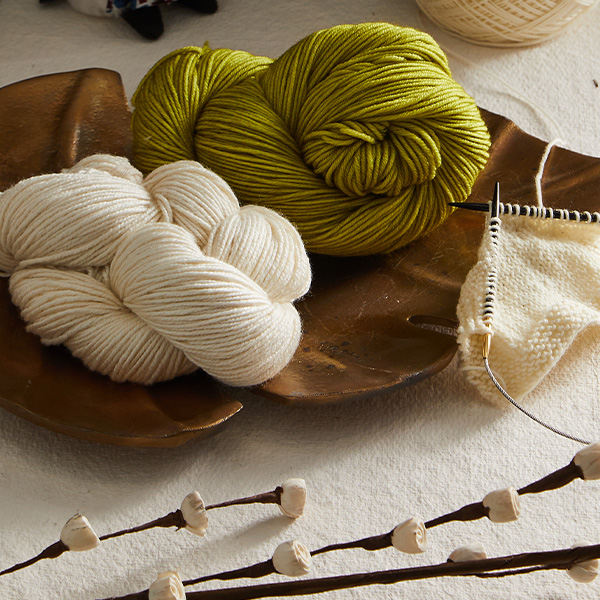The Care & Handling of Hand Dyed Yarns: Best Practices
Picture this: You have just found the perfect shade of blue with which to knit a pair of socks or a hat. It is a hand-dyed sock yarn in an extraordinary shade named Jodhpur Blue. You have the ideal double point needles and you are ready to begin. You want to make sure that gorgeous color continues to look as fine as the day you bought it. As an artisan product, hand-dyed wool deserves a little loving care. Following a few simple rules will help ensure the longevity of the yarn and the color you love.
Storing Hand-Dyed Yarn
If
you are not going to use the yarn immediately, it’s wise to keep it loosely
twisted, in the skein. Here are some points to keep in mind:
-
Do not cut the skeins ties until you are ready to wind or the
skein will tangle.
-
Store the skeins in a dust and moth-proof sealed up space.
-
Avoid open baskets or totes to prevent unwanted wool-loving moths.
When
you are ready to start, wind your yarn into a ball and start your project. In case you have not yet picked the pattern, here is a free
sock pattern from us. If this
doesn’t appeal, just google “free knitted sock pattern” and choose from the
many you will see online.
Bleeding & Hand-Dyed Yarn
While
hand-dyed yarns are relatively
color-fast, occasionally, the darker shades of hand-dyed yarn can rub off on hands or needles. This is known as “bleeding”. This
is not harmful (or as awful)as it sounds. It does not lessen the yarn’s original color. It
is a result of some extra dye residue and is easily washed off with some mild soap. If you wish to avoid the outside chance of
this, you can soak the skein in cold water before winding it up. Be sure to leave it in the skein,
with ties intact, and dip the yarn in and out of a cold-water bath. Gently wring it out in a towel and air dry it
on a rack or towel bar. Do not dry it in a dryer. Never, ever use hot water
since even superwash yarns will not like it.
If bleeding does occur, it should only happen after the first wash.
Washing Hand-Dyed Yarn
Yarn labeled “superwash”
can be washed in the wool wash or gentle setting of your washing machine, in cold
water. However, many knitters will recommend handwashing and lots of us don’t understand
why some people dread it. It is fast, easy and not messy at all. Simply
fill a basin or a sink with cold water and toss in a tablespoon of pure
wool soap. Dip your finished project in
and gently swish it about. Rinse once in
clean cold water to make sure no soap remains. Pick it up and gently squeeze
out excess water. Then simply lay the
hand washed item flat on a towel to dry.
For small items like a hat or a pair of socks, it is
fast and quick. For larger items, like a shawl or large scarf, it
is gentle treatment and will not distort
or stretch the piece the way a machine might.
Other points to keep in mind:
-
Wool does not need aggressive washing.
-
A simple out-door airing can be sufficient
and effective for larger pieces.
-
If needed, a gentle soak in cool
water as described above, usually does the job.
- NEVER wash wool in hot water (even
Superwash) as it will fade & age the piece.
Finishing & Blocking Hand-Dyed Yarn
Just
about any hand-knit project enjoys being blocked. The best time to block a piece is usually right after it’s
washed and it is still slightly damp.
Simply lay it flat on an ironing board or a towel. Accessories, such as socks, hats, mittens,
gloves and small scarfs can be shaped in place by hand. A sure-fire trick is to place an absorbent
towel on top and take a steam iron and gently hover it above the piece. You can press down ever so gently, but do not
“iron” it back and forth – just gently daub it in place. A good thing to remember is that the finer
the yarn the gentler the steaming should be.
After that, remove the top towel and let it dry thoroughly where it
lays. If the weather is warm enough and
you are able to do so, it’s nice to let it dry outside on a flat surface.
If
blocking a shawl or extra-large scarf or blanket, some people like to use
blocking wires. They are great for gently expanding and showing the true beauty
of lace work, keeping an edge straight and making sure finished work dries in
the right shape. Here’s a
simple video tutorial on using wires.
Hand-dyed yarn should be treated
as well as you would any good quality material – with loving care. Using simple
methods, such as these, you can keep it
looking vibrant and wearing well for years!





Comments
Post a Comment